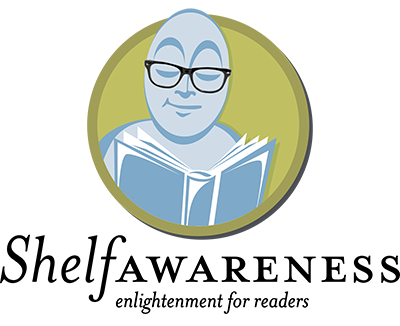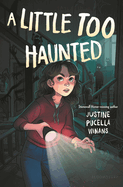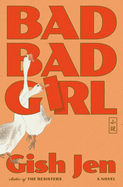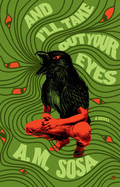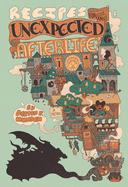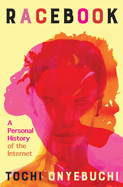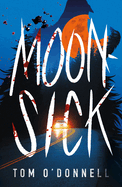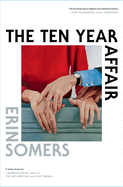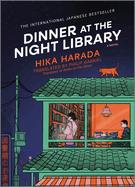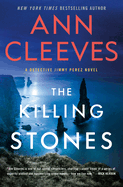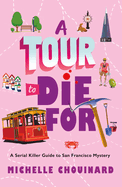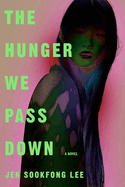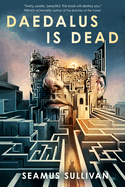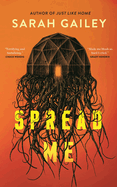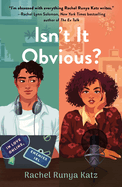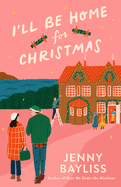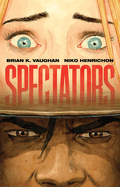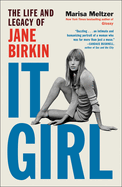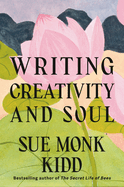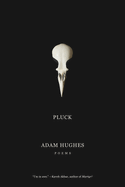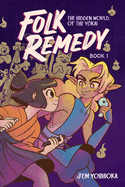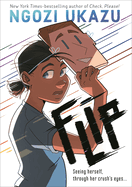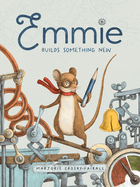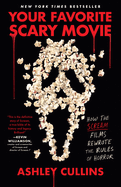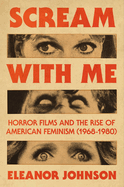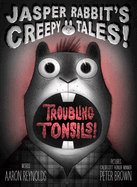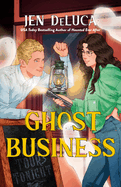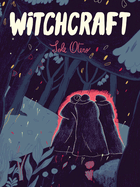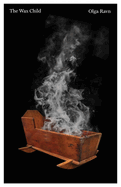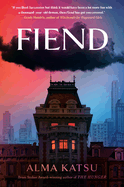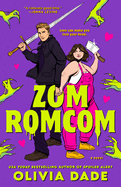Friday, October 24, 2025
If you're reveling in the final bewitching nights of spooky season, be sure to scare up a copy of Justine Pucella Winans's "eerie, captivating" middle-grade novel, A Little Too Haunted, about a 13-year-old "paranormal scholar" juggling the pressures of middle-school crushes, chronic IBS, and exorcising ghosts. And Deston J. Munden conjures up some appetizing, if unorthodox, enchantments in Recipes for an Unexpected Afterlife, a "novel of found family and fierce love," about an undead orc turned restaurateur. Or brave the chilling echoes of generational trauma in Jen Sookfong Lee's "unnerving... terrifying" The Hunger We Pass Down, whose ghostly horrors are rooted in cruel historical events. As the reassuring Ina Garten meme goes, "If you can't summon the flames directly from hell, store-bought is fine!"
Bad Bad Girl
by Gish Jen
Gish Jen's autobiographical Bad Bad Girl is a singular intergenerational novel. Jen's act of imaginative, empathetic storytelling is inspired by the author's complex, frequently antagonistic, relationship with her mother, who immigrated from China in the 1940s. Jen (The Resisters; Thank You Mr. Nixon) re-creates her mother's childhood as a privileged girl in pre-Revolutionary China, her solitary journey to pursue her graduate studies in the United States, and her subsequent life there. It's a story both deeply personal and universally resonant.
Jen skillfully navigates the cultural misalignments, the sacrifices, and fierce determination that characterized her mother's life, and later her father's, as an immigrant. In this extraordinary portrayal, Jen grapples with the reasons for her mother's abuse and favoritism, seeking clarification and offering parallels between their lives. The title itself, Bad Bad Girl, is the phrase Jen's mother often used in reference to her daughter.
The conversations feel strikingly authentic, capturing the rhythm and tone of mother-daughter dynamics. Jen movingly transforms what could have been a straightforward reconstruction of events into a vibrant, ongoing dialogue across time and mortality. Jen's prose is precise, elegant, and often witty. She has a remarkable ability to distill complex emotions and experiences into clear, evocative language. The historical context of Jen's family's journey is seamlessly integrated, providing a dynamic backdrop without ever overwhelming the personal narrative. Bad Bad Girl is a powerful reminder that while death may silence voices, it cannot extinguish the conversations that continue in our hearts and minds. This book is imperative for anyone interested in immigrant experiences, the complexities of family, and the art of writing personal history. --Elizabeth DeNoma, executive editor, DeNoma Literary Services, Seattle, Wash.
Discover: Gish Jen's autobiographical novel is a brilliant and touching emotional depiction of a conflicted mother-daughter relationship.
And I'll Take Out Your Eyes
by A.M. Sosa
A.M. Sosa uses multiple perspectives to explore the legacy of trauma and the role of memory in creating an authentic self in And I'll Take Out Your Eyes, their striking and unforgettable debut novel.
Set in the Mexican American community of 1990s Stockton, Calif., the novel opens with seven-year-old Christian waking up in the family kitchen holding a knife. His mother's attempt to use "good magic" to cure him fails, and the curse continues to manifest as he grows older. His mother's health declines, his relationship with his adored older brother splinters, and he endures constant physical abuse at the hands of his father. In high school, Christian struggles with his sexuality in a culture of repression; he drinks and gets high to escape himself and the violent city in which he lives. When Christian manages to flee to college in Berkeley, he is finally able to begin processing his trauma and discovering his true self through writing.
Sosa's language is cinematic and arresting. They often blend Spanish, most of which can be understood in context, into the narrative, adding depth and dimension. What makes their novel truly intriguing, however, is Sosa's use of multiple perspectives, combining first, second, and third person to tell Christian's story. When recounting aggression, for example, dissociative second person is used. When Christian begins writing for himself, Sosa uses first person. These shifts keep readers on edge but completely immersed in the narrative. Lyrical, fierce, and unfiltered, And I'll Take Out Your Eyes is an exciting first novel from a writer to watch. --Debra Ginsberg, author and freelance editor
Discover: This unforgettable debut novel uses shifting perspectives to explore violence, memory, and the struggle to create an authentic self through trauma.
The Ten Year Affair
by Erin Somers
Late in The Ten Year Affair by Erin Somers (Stay Up with Hugo Best), protagonist Cora meets an older woman who insists, "If you agree to share your life with someone, you're never free again. No one is allowed to say it, but it's true." Cora, fighting thoughts of escape after years of pleasant but passionless marriage to Eliot, appreciates that she eschews politeness and says it anyway. Or does she? Did Cora really talk to her, or did their conversation take place on an alternate timeline?
Cora's life has been split between two worlds for years, since she first met Sam, a neighbor dad with a sexy mouth, a square jaw, and an infant one week older than her own. Sam and Cora develop an instant friendship, despite Cora imagining much more. In fact, after Cora jokingly suggests, "We should just go ahead and have sex," it becomes a reality, albeit one in a parallel universe: "Somewhere in the multiverse their alternates checked into a hotel room."
Cora is careful to keep her fantasy world and her real world separate. Somers is careful, too, intentionally letting the steamy descriptions of one timeline blur into the ordinary details of the other. Never confusing, the narrative moves effortlessly between the real and the imagined and raises excellent questions about what happens when one gets the freedom they thought they wanted.
The Ten Year Affair is often funny, peppered with thorny observations. Somers balances the witty takes with profound introspection on the nature of commitment and longing, guaranteeing there will soon be countless readers loving The Ten Year Affair. --Sara Beth West, freelance reviewer and librarian
Discover: The Ten Year Affair blends fantasy and reality, where the world of a sexy affair runs parallel to the ordinary world of carpool, taking kids to karate, and loving but familiar husbands.
Widow's Walk
by Jane Willan
Jane Willan's engaging novel Widow's Walk follows chef-turned-parish-priest Miranda McCurdy as she navigates her new life in tiny Sparrow, Maine. Grieving her husband's death but hopeful about the potential of her new career, Miranda is eager to build relationships and nudge her congregation toward productive change. But her efforts at revamping an "insensitive and racist" Thanksgiving celebration provoke an outcry, which only intensifies when Alejandra, a young pregnant woman from Honduras, seeks sanctuary in the church building. Willan, a minister in the United Church of Christ, explores Miranda's inner turmoil as she struggles to reconcile her faith and idealism with messy human realities.
As Miranda settles into picturesque Sparrow, her hopes for progress at the church are often dashed by her congregants' stubborn adherence to their traditions. Though she has a few stalwart supporters--including Peg, the tall, no-nonsense office administrator--Miranda runs up against challenges that include limited budgets, conflicting ideologies, and her own doubts about her new career. The presence of Alejandra and the ticking clock of her pregnancy threaten to further divide the small congregation. Willan (Sister Agatha and Father Selwyn Mysteries) expertly portrays the paradox of life in a small town: deep (if fractious) bonds between neighbors who may believe and vote quite differently. As a tropical storm heads for Sparrow, both Miranda and her congregants are forced to confront their prejudices and imagine a future unlike the one they'd pictured.
With plenty of humor, heart, and mouthwatering food descriptions, Widow's Walk examines the difficulties and joys of small-town life and the complicated process of living out one's faith. --Katie Noah Gibson, blogger at Cakes, Tea and Dreams
Discover: Chef-turned-parish-priest Miranda McCurdy navigates church politics and messy human realities in Jane Willan's thoughtful, engaging novel.
Dinner at the Night Library
by Hika Harada, transl. by Philip Gabriel
Prolific Japanese author Hika Harada's delicious U.S. debut, Dinner at the Night Library, arrives notably translated by lauded Philip Gabriel. "Thirty [is] just around the corner" for Otoha Higuchi, an only child whose parents worry about her singlehood and lack of "a decent job." Strangers often ask if she was named after writer Ichiyo Higuchi, suggesting a predestined bookish career.
After temporary employment at a bookstore, Otoha is hired by the anonymous owner of the titular "Night Library" at the end of a three-hour Zoom interview. Of course, this isn't a typical library: it's only open 7 p.m. to midnight. The library's books are "from the personal collections of deceased writers, which are donated... after their passing"; patrons may visit collections but never borrow volumes. When Otoha arrives for her first day, manager Sasai seems initially curt but shows he is playful and thoughtful by day's end. The rest of the staff, too, are kind and welcoming, their warm camaraderie encouraged by exquisite late-night dinners inspired by literary meals, created by barista-turned-chef Kinoshita.
Harada uplifts librarians and booksellers, celebrating their dedication to the written word on the page. While Otoha is the primary narrator, Otoha's colleagues also share their backstories--of becoming unable to read, rescuing old books, once upon a time being a reluctant reader. Books and reading help heal each member of the library's staff (and a few patrons) in numerous ways. Working at the Night Library proves to be so much more than just another job. --Terry Hong
Discover: Prolific Japanese author Hika Harada celebrates the healing power of books in her U.S. debut about an unconventional night library.
Perfect Happiness
by You-Jeong Jeong, transl. by Sean Lin Halbert
Perfect Happiness, Korean novelist You-Jeong Jeong's third psychological thriller to be translated into English after The Good Son and Seven Years of Darkness, expertly constructs a terrifying labyrinth, littered with corpses, from which some of the innocent might escape. Sean Lin Halbert deftly translates Jeong's multilayered, polyphonic, shocking reveals.
At the epicenter of Jeong's intricate web of characters is Yuna, her many roles revealed in relation to others--mother, wife, stepmother, ex-wife, sister, sister-in-law, daughter. Yuna's daughter, Jiyoo, is her barometer; as young as kindergartener Jiyoo is, she's painstakingly learned to read Yuna's tiniest movements, hyperaware of the looming punishment for disobedience. Jiyoo's horrific nightmares reveal unbearable truths but Jiyoo can't risk the very real threat of being thrown out alone. When her beloved father, Joon-young, breaks his promise to return and disappears, Jiyoo can't control her fear. Why is her five-year-old stepbrother suddenly not breathing? Has Aunt Jane also vanished? "Happiness is subtraction," Yuna's second husband, Eun-ho, remembers Yuna saying. "It's getting rid of the possibility of unhappiness until life becomes perfect." What he thought was a path to "that perfect happiness" should have been his warning to get away.
"Trust no one," a character rightfully warns. Jeong's meticulous plotting continuously intensifies until the epilogue finally separates the living from the dead. Equally chilling is Jeong's author's note, her "first time admitting" to the "irreparable wounds" she suffered in a relationship that provided "the seed of this story." While Jeong insists Yuna's voice is never heard, her power to damage and destroy reverberates to the very end. --Terry Hong
Discover: You-Jeong Jeong's third psychological thriller chillingly stacks up the corpses before (only) some of the innocent can be saved.
Mystery & Thriller
The Killing Stones
by Ann Cleeves
Detective Jimmy Perez, a complicated and compelling character, previously appeared in eight of Ann Cleeves's Shetland novels. After a personal tragedy upended his life, Jimmy has finally found happiness again: he and Willow Reeves have a son and a baby on the way. Willow and Jimmy, both police officers, left Shetland to raise their children on the Orkney Islands, off the northern coast of Scotland. The Killing Stones is the first novel in a series following them both.
A few days before Christmas, the body of Jimmy's oldest friend, Archie Stout, is found on the island of Westray. Archie was hit over the head with one of the Westray story stones, ancient artifacts excavated on the island some years before. With help from Willow, who is essentially his boss but currently is on family leave, Jimmy reluctantly interrogates friends and family members as he investigates Archie's murder. Intense winter storms disrupt travel between Westray and the main island, preventing the arrival of backup officers from Glasgow and leaving the whole investigation to Jimmy and Willow. The case becomes even grimmer when another victim is struck at a different archeological site.
Perfect for fans of Louise Penny and Donna Leon, The Killing Stones sharply contrasts its gloomy aspects with the cheer of Christmas, leading to tension for Jimmy and Willow as they alternate between gift-shopping for their son and questioning suspects. This atmospheric and introspective novel proves once again that Cleeves (The Long Call; The Dark Wives) is a superb mystery writer. --Jessica Howard, former bookseller, freelance book reviewer
Discover: In this atmospheric mystery, two detectives in the remote Orkney Islands investigate a series of deaths during the days before Christmas.
A Tour to Die For
by Michelle Chouinard
Michelle Chouinard (The Serial Killer Guide to San Francisco) continues her highly entertaining look at family legacy in A Tour to Die For, which follows Capricorn "Capri" Sanzio, who has spent her entire life connecting the dots of San Francisco history and crime.
As a child, Capri learned that her grandfather, William Sanzio, was serial killer Overkill Bill, nicknamed for his brutality. He died in prison, proclaiming his innocence; in the series' previous installment, Capri proved that he wasn't responsible for at least two murders. Her fascination with crime led her to establish San Francisco Killer Crime Tours, which visits historical crime scenes. The business's success hinges on Capri's careful research into San Francisco's nefarious past. But some customers are more interested in hearing Capri's lurid tales of her grandfather. Nonetheless, Capri is jarred when one of her tour guests insists she sees a woman being attacked in an apartment along Capri's Barbary Coast tour. Police maintain no one is in the apartment, but Capri believes her client, especially when an artist who lived there is later found dead. Her investigation includes searching for an artifact that may contain a code to locating gold-rush treasure. Capri also struggles to write a book about her grandfather; she knows it will be successful but will also further antagonize her father, who adamantly refuses to discuss Overkill Bill.
Chouinard complements her energetic plot with frequent references to San Francisco's crime scenes and fiction, including a clever allusion to the Maltese Falcon. A Tour to Die For maps out an exciting, twisty follow-up, with enough avenues left to explore in possible future installments. --Oline H. Cogdill, freelance reviewer
Discover: A woman whose grandfather was a convicted serial killer investigates a murder that may have occurred on one of her San Francisco crime-scene tours in this highly entertaining mystery.
The Hunger We Pass Down
by Jen Sookfong Lee
Vancouver-born writer Jen Sookfong Lee's unnerving fourth novel, The Hunger We Pass Down, examines terrifying generational trauma passed from mothers to daughters in a Chinese Canadian family. Lee opens in 1938, when 13-year-old Gigi is a Hong Kong student fascinated by the stories of Nam Koo Terrace, a famous mansion with ghostly secrets she sees daily on the way to school. A year later, she's entrapped there, interminably raped as a comfort woman for occupying Japanese soldiers. Gigi will never escape Nam Koo, but her baby, Bette, raised by strangers, will begin the journey west, transporting Gigi's brutal legacy to the other side of the world.
In 2024 Vancouver, 40-year-old Alice is a single mother to recalcitrant teen daughter Luna and technologically prodigious son Luca. Her diaper business isn't quite successful enough to hire help, she's not ready to commit to her adoring lover, and she can't get through the day without alcohol. When her life is inexplicably tidied overnight--her house, her business orders--she accepts that her drunken self could be on highly efficient autopilot. The truth proves paranormal, however, and helpful quickly turns heinous.
In a note included with advance editions of the book, Lee divulges that Nam Koo is real--the building and its reported horrors. Her fiction, she admits is "sort of," alluding to her own family's intergenerational misogyny. She reveals how mothers withhold, control, and abuse daughters to ensure they're "prepared and strong when the world is trying to destroy us." Intertwining this dysfunctional family saga with cruel historical reality and spectral revenge, Lee chillingly exposes the monstrous price of women's survival. --Terry Hong
Discover: Canadian author Jen Sookfong Lee's The Hunger We Pass Down chillingly bears witness to generations of Chinese Canadian women confronting intergenerational trauma.
Science Fiction & Fantasy
Recipes for an Unexpected Afterlife
by Deston J. Munden
Youth and advanced age combine in Recipes for an Unexpected Afterlife, Deston J. Munden's cozy fantasy novel of second chances and self-forgiveness that's bursting with stunning, satisfying plot twists and characters that steal readers' hearts.
Rottgor Onyx-Ax is a millennia-old undead orc resurrected by the Worm King, the evil tyrant whom Rottgor then helped take down after being forced to commit terrible horrors in his name. Together with five other Death Knights (they're known as the Six Shadows), he founded the city of Necropolis, where necromancers could work and the undead could live in safety, but he's spent his centuries there in service of the castle. Now Lady Cleo, the heir apparent of Necropolis, forces Rottgor into a retirement in which his decaying body is restored just enough to be able to experience the pleasures of living. Tapping into his first life as Razgaif the Younger, champion and war chef of the Onyx-Ax orc tribe, Rottgor builds a restaurant with the help of a motley crew including Calfe, a shady elf-dwarf benefactor, and Astra, a young magician orphan girl with necromancy powers. When Astra's safety is threatened by those who believe the undead don't deserve the same rights as the living, Rottgor rallies to her defense and confronts his misguided beliefs about his own unworthiness.
Rottgor's self-recrimination and Astra's youthful confidence and belief in good lead readers to root for their success and happiness. A novel of found family and fierce love, Recipes for an Unexpected Afterlife is full of comfort and hope. --Dainy Bernstein, freelance reviewer
Discover: An undead orc forced to inflict horror on others learns to pursue the life he wasn't given a chance to have in this cozy fantasy.
Daedalus Is Dead
by Seamus Sullivan
Even in Tartarus, the great labyrinth builder reckons with the death of his son and confronts his failures as a father and a man in Seamus Sullivan's debut novella, Daedalus Is Dead.
Daedalus's son, Icarus, famously flew too close to the sun with the wings his father built for the two of them to escape from King Minos. The wax melted, and Icarus crashed into the sea and died. Years after escaping, building a monument to his son, and trying and failing to find any trace of Minos's daughter Ariadne, Daedalus dies of an infection. But King Minos, now also dead, judges the souls in the underworld, and even though Persephone herself takes Daedalus into her service, Minos will not allow him to see his son again. What's more, the Minotaur runs loose in Tartarus, devouring the spirits of heroes. But as Daedalus encounters people from his life, he realizes the stories he told himself about his actions don't always match the perceptions of others.
This nonchronological telling of events flits between Daedalus's time in the underworld and his memories of Icarus's childhood and their eventual flight from Crete. Sullivan heart-wrenchingly conveys a father's grief at the loss of his child. By giving the Minotaur a preferred diet of heroes, he also explores what exactly made a hero of Greek myth, and whether heroism and virtue have anything in common. The result is a devastating examination of fatherhood and masculinity. --Kristen Allen-Vogel, information services librarian at Dayton Metro Library
Discover: In this devastating examination of fatherhood and masculinity, Daedalus spends his time in the underworld reckoning with his son's death and confronting his own failures.
Spread Me
by Sarah Gailey
Following their 2022 entrance into the horror-thriller genre with Just Like Home, Sarah Gailey (The Echo Wife; Upright Women Wanted; Magic for Liars) again asks readers to confront the monster underneath the bed--except this time the bed is a desert, the monster is a shape-changing virus, and the confrontation comes with a hefty dose of sexual tension.
In Spread Me, Kinsey leads a small team of four scientists and a doctor at a remote research station in the middle of the desert. They're committed to one another and their work, coping with the extreme isolation and weather conditions with an unhealthy amount of booze, ever-rotating bedfellows, and a money jar that they pay into whenever someone references John Carpenter's The Thing. They all know the desert is alive beneath their feet, but the distance between knowing and seeing is erased when Kinsey decides to go against protocol and bring a living specimen inside the station. A crew member quickly falls ill, and the infection spreads throughout the station, with unexpected consequences. Because Kinsey has a secret attraction to viruses of all kinds, and this virus appears to want her back.
As the situation escalates, Kinsey wields her grief and anger as weapons while trying to fend off her heady desire for the virus, even as she careens toward a decision that will permanently change her life. Gailey's intriguing premise becomes an effective, propulsive novella, one that entertains even as it asks a weighty question: whether the effort of years spent resisting who one is and what one wants is ultimately what propels one toward surrender. --Kristen Coates, editor and freelance reviewer
Discover: Sarah Gailey's propulsive, erotic horror novella, Spread Me, takes place at a research outpost in the middle of the desert.
Romance
Isn't It Obvious?
by Rachel Runya Katz
Rachel Runya Katz's smart, sexy third rom-com, Isn't It Obvious?, presents a fresh take on the classic You've Got Mail premise, with two queer protagonists who fall in love over e-mail while sparks of various kinds fly in real life.
When school librarian Yael hires editor Kevin to assist with her secret podcast, she never dreams that Kevin is actually Ravi, whom Yael meets in person as he's sneaking out her window after a one-night stand with her roommate. Ravi is juggling his remote editing work with helping his brother care for his young niece, plus volunteering at the queer after-school book club Yael runs. As the friction between Yael and Ravi flares into heat, Elle (Yael's podcast pseudonym) and Kevin also fall for each other but decide to keep things professional. However, Ravi stumbles upon the truth just as Yael's podcast goes viral, and they both must decide if this relationship is worth risking their hearts.
Katz (Whenever You're Ready) excels at witty banter, peppering her protagonists' conversations (e-mail and IRL) with wry quips and literary longing. Ravi is also wrestling with complicated family dynamics, including his father's refusal to accept Ravi's bisexuality, while Yael struggles with her mental health and her willingness to risk being loved. Katz sensitively explores her protagonists' challenges and fears while gently nudging them together in swoon-worthy fashion.
Thoughtful and tender, Isn't It Obvious? is a thoroughly 21st-century romance that handles serious questions of identity, vulnerability, and belonging with humor and heart. --Katie Noah Gibson, blogger at Cakes, Tea and Dreams
Discover: Rachel Runya Katz's swoony, smart third rom-com follows a librarian-turned-podcaster and her editor as they fall in love via e-mail and trade barbs in person.
I'll Be Home for Christmas
by Jenny Bayliss
Best known for romances that sparkle with Christmas lights and love, Jenny Bayliss (The Twelve Dates of Christmas; A December to Remember) expertly ornaments the pages of I'll Be Home for Christmas with holiday cheer. Pine Bluff, Scotland, is the quintessential small town. Festive activities, charismatic characters, and the annual Christmas market decorate the town with warm, welcoming, and whimsical spirit.
Uncharmed by her unconventional aunts, hopelessly romantic mother, and eccentric neighbors, Fred Hallow-Hart moved to London nearly 20 years ago and never looked back. But after losing her job and her boyfriend, Fred returns to Pine Bluff and must face the complicated emotions she left behind. She is apprehensive that agreeing to work for her family's Christmas cracker business means that she failed to make it on her own, and self-doubt dampens Fred's holiday season. Then Ryan Frost, her best friend and crush from childhood, runs into her while dressed as an elf; he pulls Fred back into Pine Bluff's quirky traditions and reignites feelings from the past. As Fred spends quality time with her family, reconnects with Ryan, and explores a new spark with Warren Reeves, a handsome journalist covering the Christmas market, Pine Bluff slowly warms her heart.
Chapters following Fred's mother, Bella, create a multigenerational exploration of family, love, and life. Each hot chocolate, Christmas cracker, and cozy winter day brings Fred closer to true happiness in a place she never imagined finding it. Pine Bluff is the perfect place to get lost in Christmas magic. --Clara Newton, freelance reviewer
Discover: Jenny Bayliss showcases some of her best Christmas cheer and small-town charm yet in this novel about a woman who returns to a hometown where family, friendship, and love glisten like the snow.
Graphic Books
Spectators
by Brian K. Vaughan, illus. by Niko Henrichon
Brian K. Vaughan and Niko Henrichon imagine a voyeuristic afterlife in Spectators, a graphic novel about humanity's most private moments, violent urges, and collective fears.
In 2022, 43-year-old Val starts scrolling through pornography on her smartphone in a movie theater after her date bails. Then a man wearing Mickey Mouse ears and a vest labeled #LEADERBOARD strides in with a gun and a goal: to rack up the most kills in a single mass shooting. The very explicit narrative follows Val after death as she becomes not a spectator of just film and pornography but also of human existence. Two hundred years later, Val meets Sam, a cowboy from a century before Val was born. As they travel New York City together, the two discuss their lives, interpersonal connection, and--after the #LEADERBOARD challenge reappears--the impending end of the world.
Vaughan (Saga; Paper Girls; Y: The Last Man) reunites with Henrichon, his Pride of Baghdad collaborator, to provide a work as emotionally resonant as it is violent. Political events and climate change, mentioned in the background, produce a dynamic setting, and Henrichon's pencils and watercolors give an organic feel to this futuristic techno-dystopia. Placing readers in the role of spectator, Henrichon illustrates the ghosts in color while the living world is in grayscale, the way the ghosts see it.
Val and Sam watch the planet fall into anarchy as they, like the rest of the world, seek comfort during the last gasps of humanity. The result is a sex-filled meditation on media consumption, intimacy, violence, and technology. Readers won't be able to look away. --Suzanne Krohn, librarian
Discover: A mass-shooting victim becomes the ultimate voyeur as the world unravels in Brian K. Vaughan and Niko Henrichon's apocalyptic graphic novel.
Biography & Memoir
It Girl: The Life and Legacy of Jane Birkin
by Marisa Meltzer
By definition, every It Girl has a short shelf life: she's destined to be replaced by a fresher iteration. In the shimmering but substantive It Girl: The Life and Legacy of Jane Birkin, Marisa Meltzer doesn't overstate her subject's artistic talents, which weren't stratospheric, but she convincingly argues that those contributions deserve consideration.
Jane Birkin (1946-2023) was born in London to an artsy well-to-do family. Growing up, she was taunted for her "boyish" physique, which she would eventually parlay into a much-imitated look. As an adolescent, Birkin pursued acting work, which wasn't completely sidelined when, at 18, she entered into a volatile marriage to composer John Barry; they had a child in 1967, the same year she left Barry. In 1968, Birkin met the French actor and musician Serge Gainsbourg while auditioning for a French film; she would become his co-star, as well as his partner and frequent musical collaborator for the next dozen years. For a time, they were among the world's most famous couples.
It Girl leans heavily on Birkin's published diaries, but Meltzer (Glossy) is a savvy interpreter. While recognizing that her subject is a hard sell as a feminist--Birkin was always blithe about the physical violence that Gainsbourg directed at her--Meltzer exults in Birkin's free-spiritedness. In particular, Meltzer shows how her fuss-free personal style (the Birkin bag gets its own chapter) helped jettison some of the era's more onerous beauty standards for women (hourglass figure, heavy makeup). Indebted to Birkin are It Girls present and future, among others. --Nell Beram, author and freelance writer
Discover: This shimmering but substantive biography of legendary It Girl Jane Birkin shows how her fuss-free personal style helped jettison some of the era's more onerous beauty standards for women.
History
Women of the Fairy Tale Resistance
by Jane Harrington
Women of the Fairy Tale Resistance: The Forgotten Founding Mothers of the Fairy Tale and the Stories That They Spun is a stunning hardcover, filled with enchanting, full-color illustrations by Khoa Le. Jane Harrington (In Circling Flight) shares the forgotten stories of a group of 17th-century Parisian women writers, the conteuses, whose contributions have since been overshadowed by figures such as Charles Perrault and the Brothers Grimm.
The book combines biographies of seven of these writers--including Marie-Catherine d'Aulnoy, who is credited with "start[ing] the fairy tale craze"--with retellings of 13 of their fairy tales, including stories such as "Belle-Belle", which has elements that may have gone on to inspire the popular classic "Beauty and the Beast." Each chapter contains vibrant, painted vignettes and evocative scenes from the featured stories.
Using their tales to advocate for female empowerment and to fight against the tyrannical monarchy of Louis XIV, the conteuses portrayed their heroines as strong protagonists, capable of independent thought and agency.
Harrington is a lively and astute researcher, ensuring that Women of the Fairy Tale Resistance educates, entertains, and inspires. --Grace Rajendran, freelance reviewer
Essays & Criticism
Racebook: A Personal History of the Internet
by Tochi Onyebuchi
The essays in Tochi Onyebuchi's Racebook provide readers with thought-provoking and eclectic cultural criticism. They explore the art and world-building of video games. There are deep insights on the intersection of race and the Internet. Social media, of course, comes into play. With his keen eye for good sentences and impressive knowledge of literature, popular media, and the human condition, Onyebuchi (Harmattan Season; War Girls) pulls together his diverse topics using the thread of how identity exists online.
"I Have No Mouth and I Must Scream" tackles the thorny question of a Black writer's duty in times of unrest, considering the pressures and constraints placed on authors from marginalized backgrounds during the wave of outrage following George Floyd's death. "How responsible is it... to want time to be left alone, to chase joy in the hum of an Xbox?" Onyebuchi digs deeper, wondering what authors are pressured to write about and what topics might be off limits, positing that "What matters is the choice."
Elsewhere, in "Select Difficulty," Onyebuchi weaves together the experience of losing his father to cancer at 10 years old with that of playing The Last of Us--a game that is gory, terrifying, and also gorgeous. "In the postapocalyptic United States, greenery abounds. The sun sets to give you the game's own version of Manhattanhenge." It's a tender and surprising rumination on loss, storytelling across media, and the parent-child relationship.
Racebook is a feast of cultural references and a deeply considered analysis of who we are on the Internet and how race plays into the equation. --Carol Caley, writer
Discover: Racebook is a thought-provoking and wide-ranging collection of essays that consider how identity plays out online.
Writing Creativity and Soul
by Sue Monk Kidd
Sue Monk Kidd's ninth work, Writing Creativity and Soul, deftly blends practical craft advice and spiritually minded self-help as she traces her development as a writer.
Kidd (The Invention of Wings; The Book of Longings) observes that her books share "a submerged female longing for voice and self-identity." Growing up in the South in the 1950s, she learned girls must be quiet, polite, and conventional. On her 30th birthday, though, the nurse and married mother of two declared she was going to become a writer, despite her high school guidance counselor having told her it was not a career for a woman, only a hobby.
The opening section, "Moorings," recounts moments from Kidd's apprenticeship. She knew from age six that she wanted to write, but her actual career started inauspiciously when a short story she submitted to a regional magazine was returned with a note reading "THIS IS USELESS!" Honing her skills and finding confidence took many years; she offers shortcuts to both. The "Mystery" and "Method" sections consider stories' sources and the nitty-gritty of their construction. Kidd gives pointers for mining characters' motivations and achieving a good pace and sense of place. The final part, "Meaning," reflects on how writing has connected her with family and strangers alike.
The book flows easily, its rapid-fire chapters interspersing writing tips with pilgrimages to the homes of literary role models, examples from her books and others', and inspirational quotations. A trove for Kidd's fans, this accessible toolkit for budding authors is also suited to readers of Elizabeth Gilbert's Big Magic. --Rebecca Foster, freelance reviewer, proofreader, and blogger at Bookish Beck
Discover: The Secret Life of Bees didn't come out of nowhere; in her craft-meets-self-help book, Sue Monk Kidd traces her decades-long writing apprenticeship, relaying what she has learned and what it means.
Things That Disappear
by Jenny Erpenbeck, transl. by Kurt Beals
Ever lose a sock, a key, a favorite book, maybe even an errant piece of cheese in the refrigerator? Ever wonder where they went? Jenny Erpenbeck, winner of the 2024 International Booker Prize for Kairos, creates a memory palace of evanescent imagination with suggested philosophical answers in the 31 delightfully ruminative flash essays in Things That Disappear, translated from the German by Kurt Beals. With nourishing and refreshing perspective, the brief meditations on the tangible and intangible coalesce into her observation that "the word disappear has something active at its core, that there is a perpetrator in the word who makes things that I know and cherish disappear."
The "things" in question include the former East German parliament building, once representing elegance and grandeur, now "basically made only of air"; a "one of a kind Biedermeier wardrobe" deposited as "bulky trash," the wood itself "a few grams lighter" like it has lost the weight of a vanished soul; as well as intangibles, like friendships gained, lost, perhaps invisible, or never really there in the first place. What happens to time itself, particularly that moment on New Year's Eve when "one number opens and another closes" connecting a global population? Wry melancholy permeates Erpenbeck's incisive prose and keen insights. Erpenbeck's lingering hope is that the single sock, the treasured book, even the lost cheese "plunges from a very high bridge and survives the fall" and "results in their appearance in another place." --Robert Allen Papinchak, freelance book critic.
Discover: Wry melancholy permeates Jenny Erpenbeck's incisive prose with keen insights on the ineluctable vanishing point of missing objects, lost social amenities, forgotten desires.
Poetry
Pluck
by Adam Hughes
Adam Hughes's fifth poetry collection, Pluck, dramatizes the faith crisis that surrounded his departure from both Christian ministry and his second marriage.
"Certainty was my birthright," Hughes writes; "I emerged from the womb with my hands clasped in prayer.... To question was to doubt and to doubt was to sin and sin led to hell." Loss of conviction was seismic, ending his vocation as a pastor and alienating his family ("My parents worry... [t]hat I've become an apostate"). His raw, confessional poems of faith and doubt move from despair to self-deprecation and back. "One failed marriage is fine. After two, people begin to wonder," he jests. Medical concerns--Type 1 diabetes and long Covid--only compounded his woes.
Hughes alternates between stanzas and prose paragraphs. The table of contents designates the 64 poems by their first lines in brackets, like the song titles in a hymnal. The collection opens with "A Praise Chorus" and there is indeed melancholic music to much of what follows. Often, the speaker directly addresses God as "you," echoing the biblical Book of Job through plangent cries: "God, if I give you these/ bones will you make/ them into whistles?/ Flutes?... / Must I be broken/ down in order to sing?"
Alliteration, repetition, and wordplay create rhythm and intensity. The metaphors glisten: "the uterine/ darkness of morning"; "tonight I am/ a paraphrase/ of myself."
Readers will find catharsis rather than closure in this bruising, beautiful work: "It was in the wrestling that certainty gave way to clarity." --Rebecca Foster, freelance reviewer, proofreader and blogger at Bookish Beck
Discover: The 64 poems in former pastor Adam Hughes's fifth collection can be wryly funny as well as plaintive as they dramatize his crisis of faith.
Children's & Young Adult
A Little Too Haunted
by Justine Pucella Winans
In the eerie, captivating middle-grade novel A Little Too Haunted by Justine Pucella Winans (The Otherwoods), Luna Catalano--only child and self-described paranormal scholar--faces IBS, her first crush, and the supernatural.
Luna's moms are "influencers" who use their psychic powers and renovation skills to flip "haunted" houses into "warm, modern, ghost-free homes." When the 13-year-old true believer discovers her moms have been faking their footage, she furiously outs them on social media. The trio moves onto their "rebrand" project, a huge old house in Ohio, only to discover this house might actually be haunted: "GET OUT" is written on the ceiling in "dripping, dark red" and her parents' camera equipment is burned on the stove. Luna's moms don't believe in ghosts--they think Luna is causing the havoc--but Luna is certain of the supernatural. Meanwhile, Luna meets Evie, a woman who is very knowledgeable about the home's previous tenants, and disbelieving neighbor Dani who, despite her apprehensions, helps Luna hatch a plan to exorcise the ghosts and reclaim the house.
Winans authentically captures a range of middle school emotions through "winter white" Luna's stubborn retorts ("I'm not in a mood"), playful quips, and desperate desire to feel seen. The text uses grace and humor to thoughtfully navigate Luna's chronic IBS symptoms ("struggling to go to the bathroom or struggling to stop") and her newfound crush (when the girl asks if she's okay, Luna blurts, "I'm gayt. I'm great. Fine. Awesome."). Fans of Dusti Bowling and Ashley Herring Blake will likely appreciate the funny, honest narration and approach to hard truths in this suspenseful, uplifting mystery. --Kieran Slattery, freelance reviewer, teacher, co-creator of Gender Inclusive Classrooms
Discover: An enthusiastic ghost-hunting teen moves into a haunted house and must grapple with evil spirits while also navigating IBS symptoms and a queer crush in this spooky, relatable story.
Moonsick
by Tom O'Donnell
Moonsick, Tom O'Donnell's (Hamstersaurus Rex series; Homerooms and Hall Passes) first young adult novel, is a grisly supernatural thriller about a teenager facing senior year amid the horrors of a werewolf pandemic.
Five years ago, the highly contagious Rabies lupinovirus emerged, turning humans into rampaging werewolves. The militaristic Viral Containment Task Force ("Dogcatchers") fights the virus by forcing infected individuals into lifelong quarantine, hunting down werewolves, and euthanizing dogs. "White girl from the suburbs" Heidi Mills's privileged life has barely been impacted--she has an imperious mother, a charming yet controlling boyfriend, and a dream of attending Harvard. Sure, there are frequent saliva tests, mandatory full-moon lockdowns, and other government-mandated protocols, but getting infected is "the kind of thing that happen[s] to others." When a home invasion goes terribly wrong, Heidi is infected and the 18-year-old is forced to juggle two conflicting identities: "smart, pretty, popular" high school senior and secret werewolf on the run.
Moonsick is unsettling (featuring a version of the classic monster with "a misshapen nightmare of a face" and talon-like hooked claws) and deliciously gory: during Heidi's first full-moon transformation, she "writhe[s] in the puddle of her own bile," as "patches of dark, wet fur" burst from the "ragged holes where [her skin] tore open." O'Donnell's pandemic twist on the werewolf genre allows for insightful social commentary on the poor's increased vulnerability to the virus, while occasional chapters from Erik Balikian's perspective as a rookie Dogcatcher underscore the insidious dangers of militarism, conspiracy theories, and dehumanizing the sick. Moments of comedic relief and an enemies-to-lovers romance allow periods of ease between toothsomely terrifying scenes. --Cristina Iannarino, children's book buyer, Books on the Square, Providence, R.I.
Discover: A gory, propulsive thriller about the horrifying consequences of being a teenager and a werewolf in an anti-lycanthropic world.
Folk Remedy
by Jem Yoshioka
Japanese New Zealander comics artist Jem Yoshioka makes her middle-grade debut with the first book in the Folk Remedy series, an exhilarating, otherworldly adventure centering family legacy, loyalty, and friendship. Takeyama, "a sleepy town in the countryside," is home to Morimura's Apothecary. Their telephone is still quite new, a modern convenience young Maple appreciates, but her mother insists it's "a kitsune trick": "How can we trust it's really a human on the other end?" Maple tries again to convince Mother "the world is changing. We don't need those old [yōkai] stories anymore." But Mother teaches Maple the family secret: "every generation for the past 500 years has used this book to share their yōkai stories... we inherit the book, we learn from it... and we record our own experiences in it... so that the next generation can also learn." Mother also reveals that their lantern holds a yōkai who has been trapped inside for 300 years. Maple decides the lantern can substantiate her doubts: if "no yōkai comes out, I'll have proven to Mother that they don't exist." Except Ember emerges, angry and ready to leave.
Maple--her expressions, her humor, her tenacity--entertainingly dominates Yoshioka's panels as she struggles between centuries-old tradition and quickly changing modernity. Yoshioka varies her color palettes accordingly, reserving predominantly earth tones for Mother's world and relying on purples, pinks, and blues for glimpses of other realms, brightening and heightening the saturation the further Maple travels from home. The final page turn is exactly the kind of cliffhanger that will have audiences clamoring for Book Two. --Terry Hong
Discover: Jem Yoshioka introduces lively young Maple, whose disbelief in yōkai gets inventively, entertainingly debunked when she releases Ember from 300 years of entrapment.
Flip
by Ngozi Ukazu
Cartoonist Ngozi Ukazu (Check, Please!; Bunt!) combines introspective discussions of identity inspired by The Bluest Eye with Freaky Friday-style body swapping to create Flip, an earnest, contemplative graphic novel about two teens who suddenly switch bodies.
Brown-skinned Mission Springs Prep senior Chi-Chi plucks up the courage to ask her "rich white boy" crush, Flip, to the senior festival. She creates an elaborate promposal and e-mails it to him the day before presentations in their AP English class. Flip mistakes the video for his class presentation and plays it in front of the class--Flip's rejection is kind ("I'm sorry Chi-Chi. I just... don't know you that well") but public. Embarrassed Chi-chi runs out of the classroom and silently excoriates herself, wishing Flip Henderson liked her. While outside, she slips, hits her head, and envisions herself taking a doll-sized Chi-Chi apart. When she wakes, she's in Flip Henderson's body--and, of course, Flip is in hers.
Thickly lined panels zig-zag across the page or overlap in moments of action and intense emotion. Like Pecola Breedlove's belief she will be beautiful if she has blue eyes, Chi-Chi believes she will have value if Flip loves her. Ukazu uses this to include a visual cue: any time Flip is inhabiting Chi-Chi's body, her eyes are blue. Both Chi-Chi and Flip are forced into self-reflection: Chi-Chi calls out Flip for his unconscious bias around race and sexuality; Flip forces Chi-Chi to recognize the violence in how she speaks to herself. Flip is a rare graphic novel that should please readers of literary fiction and comics. --Kharissa Kenner, school media specialist, Churchill School and Center
Discover: Ngozi Ukazu remarkably brings The Bluest Eye and Freaky Friday together in this humorous yet weighty graphic novel about two teens--a white boy and a Black girl--switching bodies.
Emmie Builds Something New
by Marjorie Crosby-Fairall
Delightful and visually inventive, Emmie Builds Something New by Marjorie Crosby-Fairall (illustrator, The Boy in the Big Blue Glasses) is set in a dusty attic brimming with "things no-one wanted." Though Emmie the mouse is small, she is an inventor, engineer, and dreamer, transforming cast-offs into fantastical contraptions. Her attic is packed with visual treasures, and Emmie's many "clever creations" are as much a joy to study as they are to imagine in motion.
Emmie's imaginative world is upended when a "huge problem" appears, its presence announced by a looming feline shadow. With her trademark ingenuity, Emmie leaps into action. "She built something new," the text repeats, a refrain that pulses with momentum. Each solution grows more elaborate: a lion-shaped machine, a bat-winged gadget, and, finally, an elephant outfitted with a discarded watering can that sprays water. But when the water-spewing elephant robot succeeds, Emmie notices something unexpected: the cat isn't menacing; it's frightened. Emmie responds with compassion, offering an apology--a final invention that is not a weapon but a welcome.
Crosby-Fairall's text is driven by action verbs (Emmie sketches, scavenges, paces, and ponders) and uses a satisfying structure to build tension before gently dissolving it. The cool-toned palette adds to the atmosphere, giving the attic world a muted glow that feels both forgotten and full of potential. The perspective shifts and textured lines bring Emmie's world to life with energy and wit. The illustrations brim with mechanical marvels and visual riddles, and the story hints at broader ideas: that even long-held assumptions, like cats and mice being enemies, can be reimagined through curiosity, creativity, and a little kindness. --Julie Danielson
Discover: Inventive, detailed, and unexpectedly tender, Emmie Builds Something New celebrates the power of imagination and the surprising places it can lead.
Spooky Season
The Writer's Life
Tochi Onyebuchi: Reassembling the Fractured Self
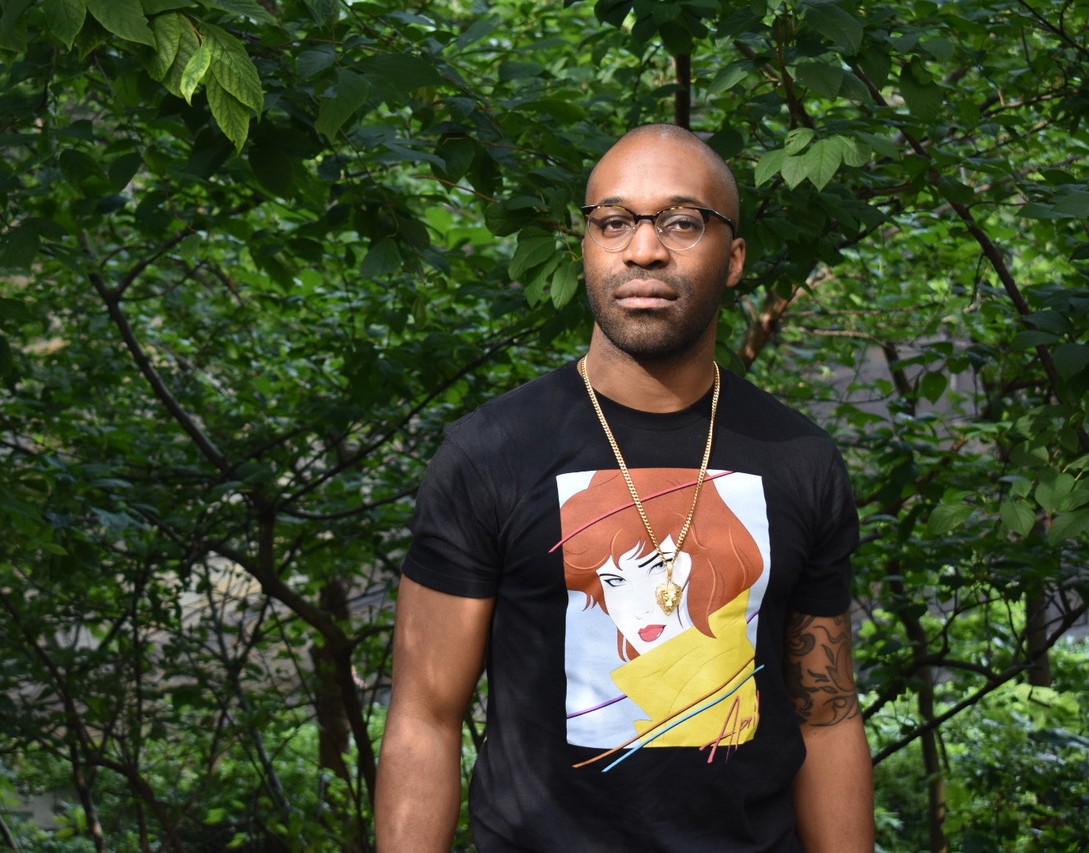 |
|
| Tochi Onyebuchi (photo: Christina Orlando) |
|
Tochi Onyebuchi is the author of Harmattan Season, Goliath, and Riot Baby, as well as young adult novels, including War Girls. His collection of essays, Racebook: A Personal History of the Internet (Roxane Gay Books; reviewed in this issue), explores the intersection of the Internet and identity in a series of chapters connecting topics such as video games, social media, and race.
This book is such a fascinating combination of subjects we love to talk about (video games, social media, replicants) and topics of critical importance (race, gender, social justice). Did you set out to write an essay collection on this particular intersection of ideas?
Some of these essays had been out in the wild before I started this collection. Looking at them I saw hints of a through line in the idea of a holistic self and how the Internet can fracture that. It allowed me to get an essay on Afrofuturism into the same collection as an essay on Call of Duty. We contain multitudes, and I wanted to write about the role of the Internet in allowing us to or preventing us from expressing that.
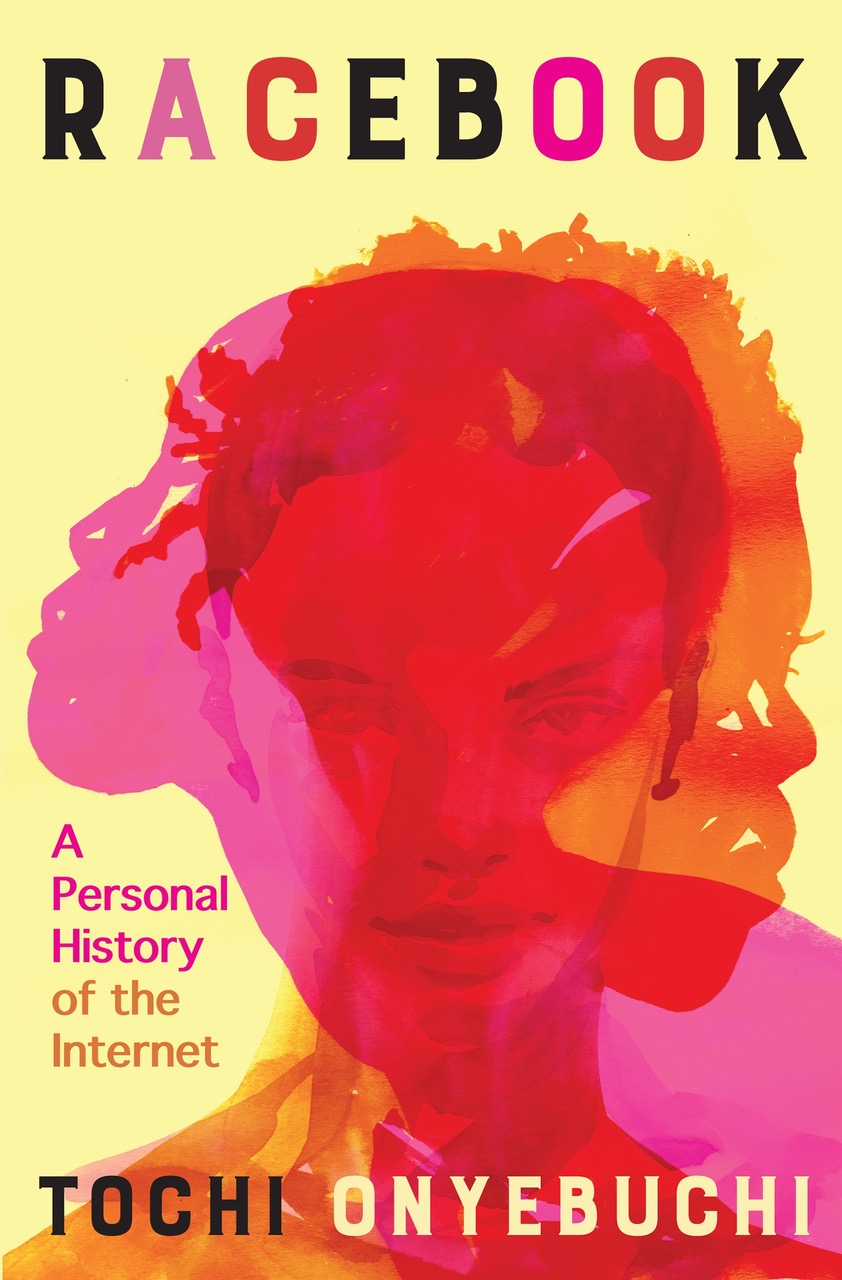 You say that the Internet can fracture the self--can you explain?
You say that the Internet can fracture the self--can you explain?
When you get on the Internet you can feel like a commoditized data point, like you're just one slice of your identity. All the rest of you--your favorite band, the school you went to, all of that other stuff--gets relegated to the sidelines. It changes how we perceive ourselves.
I'm interested in the idea of "emotional contagion" in social media, something you talk about in the opening essay. What does that mean, and why does it matter in our age of ubiquitous social media?
I think we've known for a long time the effect that being chronically online can have on a person. If all the people around you are feeling awful about a particular thing, it's impossible not to be affected by that. But now it's no longer just people in our immediate social circle that can affect our moods, it's anybody.
In the essay "I Have No Mouth and I Must Scream," you write about Black people killed by police, as well as ISIS decapitation videos: "The murder is the severing of the head. Social media is the pike on which it is planted." That's such a powerful line.
People shared those videos with noble intentions and a desire to educate others. But it had a multitude of effects. It can be massively triggering to people from those demographics. There's no right answer about any of this stuff, but in that period in 2020 a lot of media was being shared without regard for the different ways it could be affecting people. The way social media works makes it hard to avoid. At the time Facebook was autoplaying videos on people's newsfeeds before they had a chance to pause it or know what was happening. I don't know if I have conclusive thoughts on what it means for these to be shared so pervasively, but all of these thoughts were at work in my head when I wrote those sentences.
In "White Bears in Sugar Land," you discuss N.K. Jemison's landmark Broken Earth trilogy in the context of whether "Authors from marginalized backgrounds may, with varying degrees of success, deny the more pernicious aspects of American publishing and refuse to write their marginalizations, to allegorize them even, or to reduce themselves and their demographic to suffering. What matters is the choice." Why is that series such an important example to consider?
First, they're just so good. But I related to those books, too, because they're so nakedly political and dealt explicitly with the nature of oppression, with vengeance, and the ways in which vengeance and justice can braid together but also diverge. So much of that felt so revolutionary on the page.
But that idea around the choice being what matters was another seed for where this essay collection came from. I looked back at the books I've written and wondered if the self that initially fell in love with writing would recognize the writer that I'd become. I felt duty-bound to write them. There were so many other topics I'd wanted to write about. I didn't know if that earlier me would recognize the writer that I am today, and I wasn't sure how to feel about that, so I decided to write an essay collection about it.
You challenge ideas about what genres should be political. Why do you think there's a notion that speculative fiction isn't a place for politics--and is that changing?
I think it's been changing for a while. There have been bits of upheaval that have gone through the industry and the push-pull has been there for a while now. I think one of the ways to see it is in who is able to write what and who is being celebrated. Seeing change there makes me optimistic for the genre.
You tell a story about someone in an early writing workshop with you intuiting something about your personal life from your writing. How much of yourself do you think ends up in your work?
I'm such a poor judge of that. There's always more of me in my work than I think there is. In the very beginning, I was writing about assassins and samurais. I thought it had nothing to do with me, though even that had me in it. But in the summer of 2013, when I was doing human rights work in the West Bank, I wrote a short story that would eventually become Goliath. It was the first time I had written about Black people. It felt to me that this story was leaps and bounds above what I'd been doing before on a craft level. It seemed that incorporating more of myself could result in better work.
Racebook is just packed with millennial nostalgia. Tell me, what was the best decade and why was it the '90s?
It absolutely was, particularly it was the best decade to have grown up in the U.S. We could get off school, no parents at home, and just go chill at a neighbor's house. People in the neighborhood just trusted each other like that. We could still, by and large, trust institutions. Life at the time was so Edenic. There were trusted common spaces, so I could spend the whole day alone at the YMCA then go straight to the public library. Of course, I'm speaking to my own very particular experience, but things felt simpler--and we had PBS.
Of course, I have to ask you for book recommendations. What three books should we all add to our lists?
I read The Savage Detectives by the late Chilean author Roberto Bolaño maybe a year or two ago. It's been a long time since I've been surprised by a book, whether it's structural or plot-wise or what have you, but that one was nothing but surprises. Impeccable on a craft level, and it's a great distillation of everything that's great about Bolaño.
My second recommendation is one I always include when I get asked this question. A Brief History of Seven Killings by Marlon James, which is maybe the most audacious book that's been published in the last decade. It's As I Lay Dying, but with the central event being the 1976 assassination attempt of Bob Marley and it's something like 85% in Jamaican patois.
My third book is The Parisian by Isabella Hammad, which tells the story of a young Palestinian man in the early 1900s who goes to France to study to become a doctor. It becomes an elegiac portrait of early Palestine, and it's such a different portrayal of that place than we usually get. --Carol Caley, writer
Book Candy
Book Candy
Mental Floss asks "Can You Match the Opening Line to the Horror Novel?"
---
A "very significant" unpublished story by Jack Kerouac, described as "a lost chapter of the On the Road saga," has been discovered, the Guardian reported.
---
On Crimereads, Stephen King "reflects on the adaptations of his work."
Rediscover
Rediscover: Alison Rose
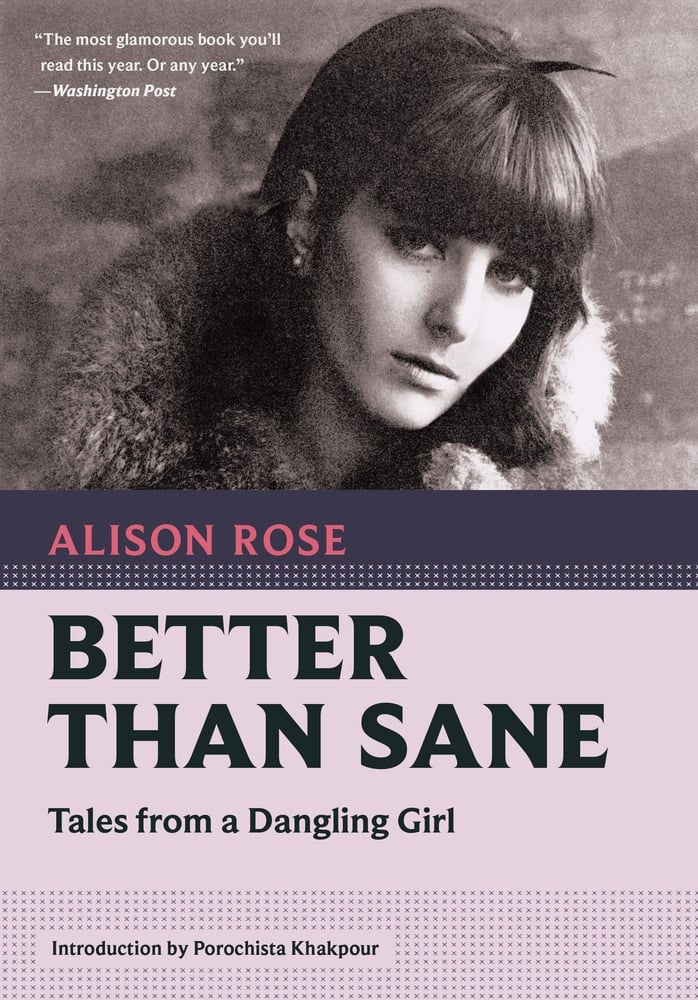 Alison Rose, "a beguiling, if inept, receptionist at the New Yorker who found her way into the magazine's pages with her idiosyncratic essays and profiles--including one particular article about her time there and the men who were her mentors and lovers that landed like a grenade and became the basis of a memoir," died in late September, the New York Times reported. She was 81.
Alison Rose, "a beguiling, if inept, receptionist at the New Yorker who found her way into the magazine's pages with her idiosyncratic essays and profiles--including one particular article about her time there and the men who were her mentors and lovers that landed like a grenade and became the basis of a memoir," died in late September, the New York Times reported. She was 81.
Rose was 41 when she took the receptionist's job on the writers' floor of the New Yorker, which was still in its longtime home on West 43rd St. Although her job was a coup, she was aided by Brendan Gill, a family friend.
Harold Brodkey, one of the many New Yorker writers "who scooped her up, told her, 'Build a life out of bad judgment.' He added, 'I have,' " the Times wrote, adding that "she wrote that down and taped it to her refrigerator. And as admirers collected in her glass cubicle, opining on this or that but mostly on Ms. Rose's many charms, she wrote down their aperçus, too."
Her "epigrammatic" mentors also included George W.S. Trow, the cultural critic best known for his essay "Within the Context of No-Context." He told her, "Darling, we're almost like other people." Brodkey wrote on one of her message pads: "What an admirably dark person you are." The two men argued about Rose's place in the world, with Brodkey contending she was "the princess of the 20th century," and Trow countering: "No, Alison is the duchess."
Rose called the New Yorker "school," studying hard, reading back issues, and writing notes to her boyfriends, a trio of married writers she nicknamed Europe, Mr. Normalcy and Personality Plus, who all wrote back to her. "This made her a less-than-attentive receptionist. She was an erratic message-taker, and her cubicle was often so full of her coterie that she failed to notice when a visitor needed to be buzzed through," the Times wrote, adding: "Inevitably, she was fired."
She began to write, and work as a literary assistant to Trow, a pairing that was encouraged by Charles McGrath, then an editor at the New Yorker and later the editor of the New York Times Book Review. Together, she and Trow produced Talk of the Town pieces. By the time he dropped her as his project and friend, she was writing on her own and back in the New Yorker's building, with her own office.
When Tina Brown became the magazine's editor, she encouraged Rose to write about her romantic life. "How I Became a Single Woman," which appeared in 1996, "caused a minor ruckus at School. Despite their nicknames, the married men were easily identifiable, and that meant upsets at home and the snubbing of Ms. Rose at the office. It also earned her a book deal, a sizable advance and a terrible case of writer's block," the Times noted.
"She felt she got paid for losing the pleasures of her life," said author and friend Honor Moore. "She was very neurotic, which both blocked and helped her; it made her writing singular, and also kept her from more achievement."
It took Rose eight years to finish Better than Sane: Tales from a Dangling Girl, which was published in 2004 to good reviews but not wide acclaim. By then, she was one of the writers cut from the New Yorker when the magazine moved into Condé Nast headquarters in 1999.
"She was so clever," said editor Sarah Crichton, who worked on Rose's memoir for a time. "So gimlet-eyed. So in-her-own-musical-in-her-head. Most of the time, you couldn't figure out what the musical was, and sometimes she couldn't.... I was thinking how great it was she finished the book. She really wanted to have written a book." In 2023, Godine brought Better Than Sane back into print at the suggestion of author Porochista Khakpour.
"I think she's the last of the great New Yorker eccentrics," McGrath said. "She was an original."
| Advertisement Meet belle bear! |

